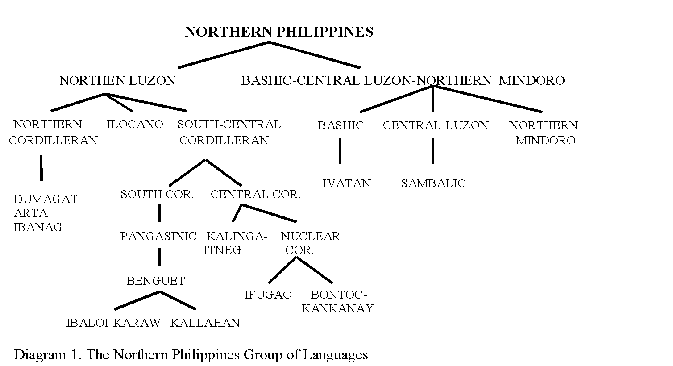
- Online Papers
- >
- Philippine Linguistics
- >
- The Languages of the Philippines
|
|
The Languages of the Philippinesby Jessie Grace U. RubricoThere are over a hundred native languages in the Philippines. Except for Chavacano, all of them belong to the Malayo-polynesian subgroup of the Austronesian family of languages. Chinese -Mandarin and Fookein, as well as Spanish are also used by some sectors of Philippine society. English is one of the country’s official languages, Filipino is the other official language. Eight languages with the most number of native speakers are considered major languages. These are Cebuano, Tagalog, Ilokano, Bikol, Hiligaynon, Waray, Kapampangan, and Pangasinense. Ilokano and Tagalog are the lingua franca in Luzon; and Cebuano in the Visayas and Mindanao. Filipino is the national lingua franca. Philippine languages may be classified into six subgroups: Northern Philippines, Southern Philippines, Meso-Philippines, Southern Mindanao, Sama-Bajaw, and Celebes Sangir. I. The Northern Philippines GroupThis is divided into two subgroups: Northern Luzon and Bashic -Central Luzon-Northern Mindoro. The Northern Luzon subgroup is composed of Southern Cordilleran, Ilokano, and South-Central Cordilleran; The second subgroup is composed of Bashic, Central Luzon, and Norhtern Minodoro languages. This is diagrammed below:
Table 1 Classification of the Northern
Luzon Subgroup (NP 1)
Table 2 The Bashic-Central Luzon-Northern
Mindoro Subroup (NP 2)
II. Southern Philippines GroupTwenty-three languages comprise this group. Subanon, Manobo, and Danao are its major divisions.
Diagram 2 Southern Philippines Language Group III. MESO PHILIPPINESThis group has four subgroups, namely: Southern Mangyan, Kalamian, Palawan, and Central Philippines which in turn is subdivided into Tagalog, Bikol, Mansaka, Mamanwa, and Bisaya. There are five Bisaya subgroups --Southern, Cebuan, Central, Banton, and Western.
Diagram 3. The Meso-Philippines Group This Group includes (1) South Mangyan: Batangan/Buhid, Tawbuid (Eastern), Tawbuid (Western), Hanunoo; (2) Kalamian: Agutaynen, Kalamianen, Tagbanwa; (3) Palawan: Batak, Molbog, Palaweño, Tagbanwa; (4) Central Philippines -- (a) Tagalog; (b) Bikol - Agta (Isarog, Iraya, Iriga), Naga, Virac, Albay, Rinconada, Pandan; (c) Mansakan -- Davawenyo, Kalagan, Tagakaulo, Kamayo, Isamal, Caraga, Mansaka, Cataeleño (d) Mamanwa; at (e) Bisaya.
Diagram 4. The Bisaya Languages. The languages in this group are: : Aklanon, Calayunen, Cuyonon, Malaynon, Kinaray-a, Ratagnon; Looknon, Ati, Romblomanon, Sorsogon Gubat, Sorsogon Bicol, Waray; Capiznon, Hiligaynon, Masbatenyo, Porohanon; Surigaonon, Butuanon, Tausug; Cebuano; Bantoanon; Mabinay Ata, Negros Oriental, Ayta (Sorsogon), Ayta (Tayabas), Karolanos (gitnang Negros), Magahat (Southwestern Negros), and Sulod (Tapaz, Capiz). IV. SOUTH MINDANAOThe followingare the languages in this Group Blaan Koronadal, Sarangani Blaan, Tboli; Tiruray, Bagobo ~ Giangan.V. SAMA-BADJAW.The seven languagesin this group are classified into (a) Abaknon; (b) Yakan; and (c) Sulu-Borneo which includes Jama Mapun, Pangutaran Sama, Sama Balangingi, Siasi Sama, Sibutu.VI. CELEBES SANGIRCELEBES SANGIR is spoken in Balut and Sarangani Islands.CREOLE.Chavacano is a creole.It does not belong to the Austronesian family of languages. Its lexicon is Spanish bur its syntax is similar to that of other Philippine languages. Chavacano is spoken in Zamboanga, Basilan, Cavite, Ternate, and Ermita (Manila).Maguindanao, Tausug, Maranao, and Ibanag complete the first dozen of Philippine languages with the most number of speakers. Four Philippine languages are listed by the Summer Institute of Linguistics (SIL) in the "Top 100 languages by Population" --Tagalog (number 57), Cebuano (# 61), Ilokano (# 91), and Hiligaynon (#100). It is also worthwhile noting that some of these languages now are on their way to extinction: Agta (Alabat Island, Camarines Norte, Iraya); Northern Alta (Baler Negrito, Ditaylan Alta, Ditaylin Dumagat); Arta (of Aglipay and Nagtipunan in Quirino Province); Ata (Mabinay, Negros Oriental); Ayta (Sorsogon, Tayabas); Batak (Babuyan, Tinitianes, Palawan Batak); Katabaga (Bondoc Peninsula). CLASSIFICATION
OF PHILIPPINE LANGUAGES
Next Page :
References
|


 2
2

